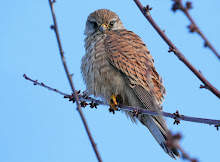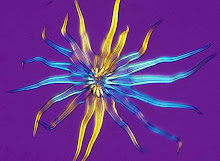If I was a fastidious gardener I'd probably have dug out the dandelions in our garden long before now because they seed themselves so prolifically, but instead I've been watching the constant stream of bees - with their pollen baskets stuffed full of orange dandelion pollen - visiting the flowers all afternoon. There are golden drifts of dandelion flowers everywhere just now - along road verges, on waste ground and in pastures - and every year they provide a reliable source of vast amounts of pollen and nectar for bees.
The strange thing is, though, that dandelions don't need
nectar, pollen or pollinators to produce a full crop of seeds. Bee and
dandelion bloom might seem like a perfect example of a partnership between pollinator
and plant, with generous rewards for services rendered by the insects, but this
is really a very one-sided relationship.
At first glance it might seem that the elaborate mechanism
that dandelions Taraxacum officinale use for presenting pollen to
visiting insects is a masterpiece of functional design. Look across the top of
a dandelion flower with a magnifying glass and you can see a forest of stigmas,
divided and curled back at the top of a long style covered in pollen. This is
the last stage in a developmental process that begins in the flower bud ....
.... where at this stage the individual florets that make up the flower head (capitulum) are just on the point of flowering. From the bottom upwards in the photo above, first you can see the ovaries that contain the egg cells that will become the embryo in the seeds, then above them are the stamens, joined in a long yellow cylinder.....

... seen here in a single floret. Notice how even at this stage
the ring of feathery hairs (the pappus), that will form the parachute that will carry the mature seed aloft
on the breeze is already well developed. This floret is one from the centre of
the flower and has no petal, unlike those around the edge that have ray petals
for advertisement ....
... like this one, where you can see the single petal
attached. At this later stage of development the style has now elongated
inside that cylinder of stamens, forcing its way upwards like a
piston and sweeping out the pollen as it goes, then splitting at the tip to
reveal the receptive stigma where pollen delivered by a visiting insect will
germinate.
The outer surface of the style is covered in a forest of
short hairs that help to sweep the pollen out of that cylinder of stamens.
Pollen adheres to the outseide of the style until an insect arrives and
collects it, at the same time cross-pollinating the stigma with the pollen from
another that it arrived with.

But to the dandelions, all of this elaborate floral
choreography is redundant - a waste of energy.
At some point in their
evolution they acquired mutations that allows their ovules (above) to
develop into seeds without any need for pollination, producing clonal,
identical copies of the parent plant. It's a process called apomixis,
that's also found in several other plants, including some bramble species.
So in
dandelions all that complex and energetically expensive floral development
and the provision of pollen and nectar to attract pollinating insects now
serves no purpose - it's a legacy of an earlier stage in evolution, when
dandelions did need to be cross pollinated. In some species of dandelion
the pollination mechanism is still functional, but not in the apomitic common
dandelion Taraxacum officinale.
Nevertheless, all that redundant nectar and pollen is a wonderful asset for bees and for butterflies like....
...the orange tip, and .......
...the peacock



































